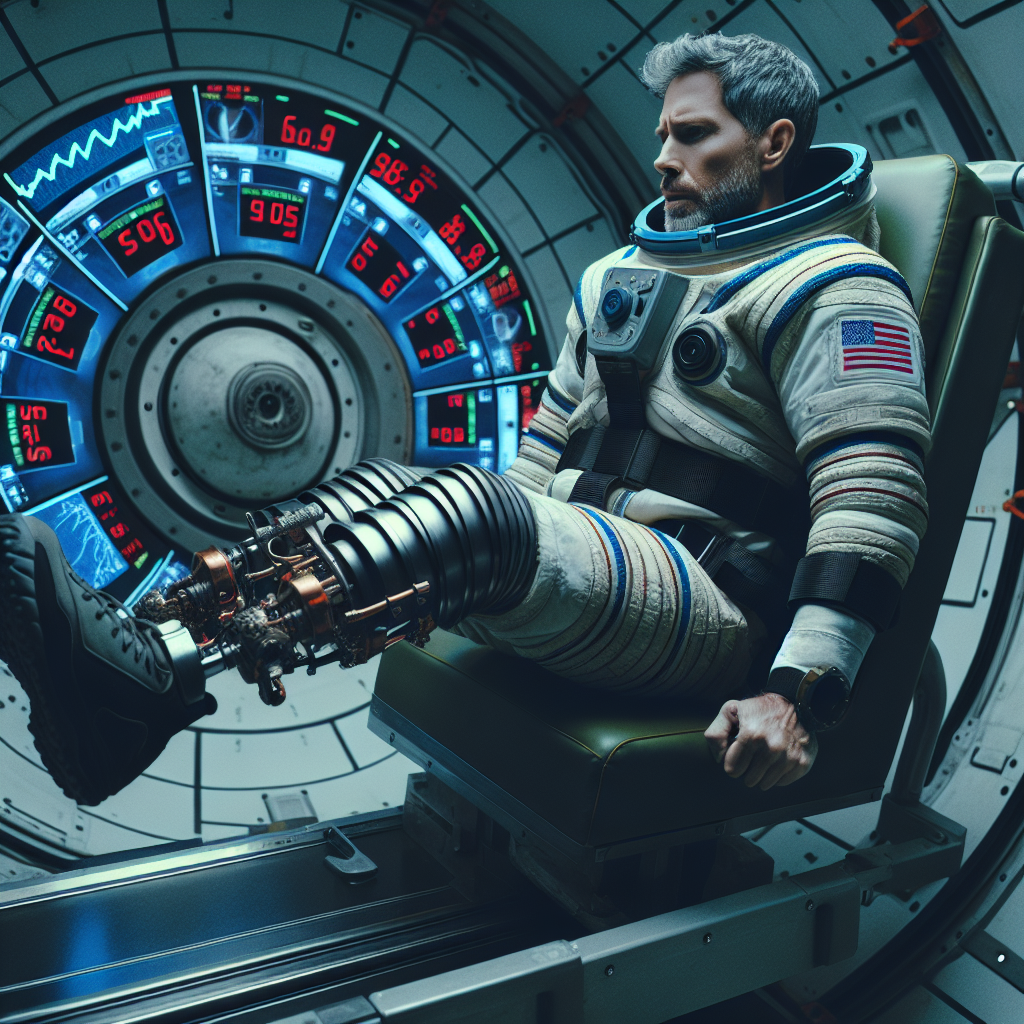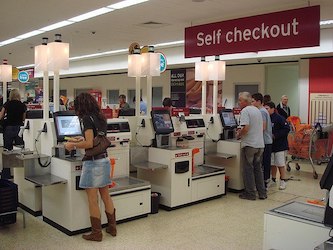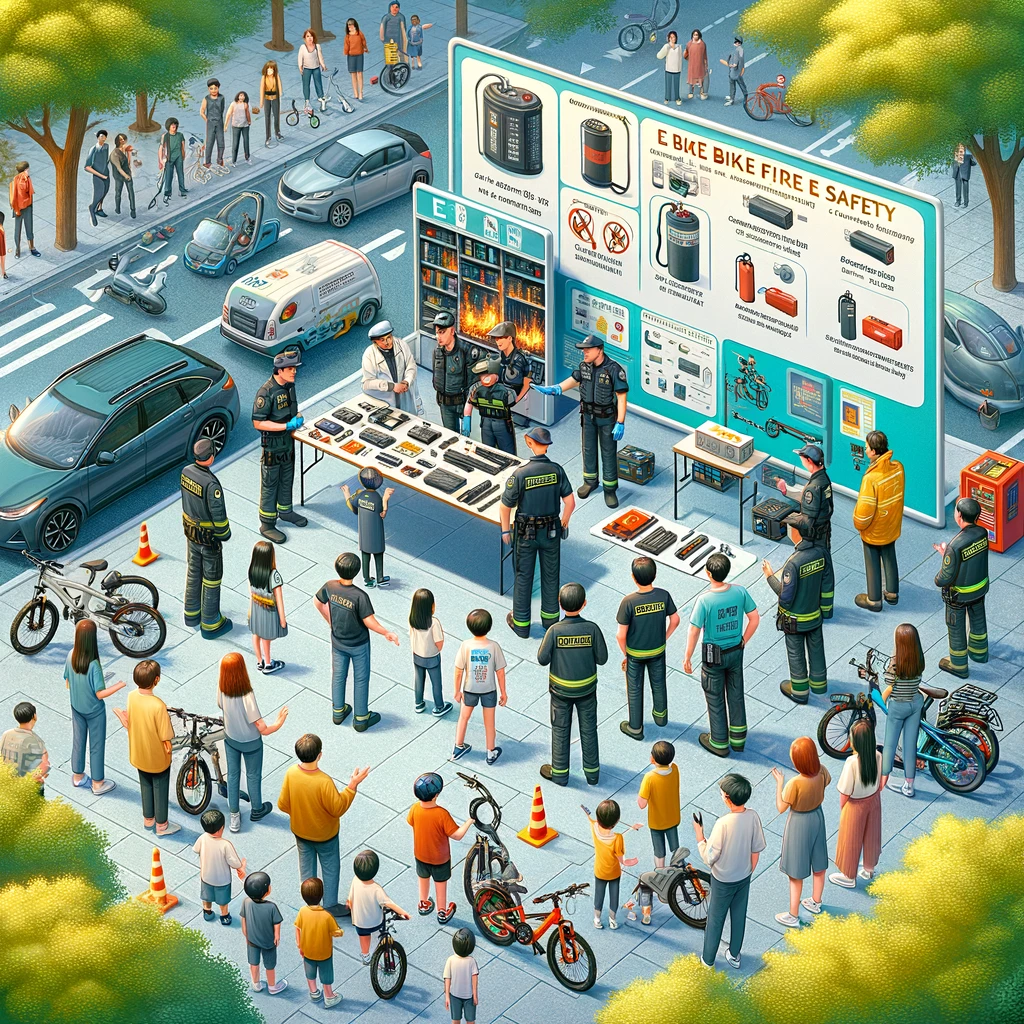John McFall, a former Paralympian, is working with the European Space Agency (ESA) on a cool study to see if people with physical disabilities can live and work in space. As part of his training, McFall recently did a test in a big machine that spins around really fast to copy the forces you feel when a rocket takes off and comes back to Earth. The test went well, and McFall’s missing leg didn’t cause any big problems. This study wants to find out if we need to change anything about spaceships, spacesuits, or prosthetic limbs to make space travel safe for people with disabilities.
McFall, who lost part of his right leg in a motorcycle accident, is now checking his special running blade that he uses for exercise. He also tried out a special treadmill that makes you feel like you’re floating in space, just like on the International Space Station (ISS). McFall noticed that his blade didn’t work as well when he was lighter, so he thinks he needs a more flexible one. He also found out that his computerized prosthetic leg needs to be adjusted when he’s in a spaceship. He might need different prosthetic legs for different things he does on the ISS.
This project with McFall is the first time any space agency has thought about having people with disabilities as astronauts. But the head of the European Astronaut Centre, Frank De Winne, thinks that people like McFall have special skills that can be used for space missions. McFall’s family has moved to Germany to support him during the study.
McFall is halfway through the project and hasn’t faced any problems that would stop him from going to space. He wants his journey to show people that individuals with disabilities can do amazing things and inspire others to follow their dreams. Most importantly, McFall wants to be known as John, an astronaut who happens to have a physical disability.
Original news source: The man on a mission to open up space to disability (BBC)
🎧 Listen:
Slow
Normal
Fast
📖 Vocabulary:
| 1 | Paralympian | An athlete who competes in sports events for people with physical disabilities |
| 2 | prosthetic | An artificial body part, like a leg or arm |
| 3 | treadmill | A machine you can walk or run on while staying in one place |
| 4 | astronaut | A person trained to travel and work in space |
| 5 | flexible | Able to bend or change shape easily without breaking |
| 6 | disabilities | Physical or mental conditions that limit a person’s movements, senses, or activities |
| 7 | agency | An organization or company that provides a particular service |
| 8 | mission | A specific task or job that is done, especially one that involves travel |
| 9 | inspire | To motivate or encourage someone to do something |
| 10 | journey | The act of traveling from one place to another |
| 11 | support | To give help or assistance to someone |
| 12 | exercise | Physical activity that you do to make your body strong and healthy |
| 13 | computerized | Controlled by a computer |
| 14 | spaceship | A vehicle designed for travel in outer space |
| 15 | study | A detailed examination and analysis of a subject or situation |
Group or Classroom Activities
Warm-up Activities:
– News Summary
Instructions: Divide the class into pairs or small groups. Give each group a few minutes to read the article. Then, ask them to summarize the main points of the article in a short news summary. They should focus on the key information and use their own words to explain the main ideas. Afterward, have each group share their summaries with the class.
– Opinion Poll
Instructions: Ask the students to form pairs or small groups. Give each group a few minutes to discuss and share their opinions on the topic of people with disabilities living and working in space. Then, have each group create a set of questions for an opinion poll. Each group should ask their questions to different students in the class, recording their answers. Finally, have the groups share their findings with the class and discuss the different opinions.
– Sketch It
Instructions: Divide the class into pairs. Give each pair a few minutes to read the article. Then, ask one student from each pair to describe a specific scene or concept from the article while the other student sketches it. Afterward, have the pairs switch roles and repeat the activity. Finally, have the students share their sketches and discuss the different interpretations.
– Vocabulary Pictionary
Instructions: Write a list of vocabulary words from the article on the board. Divide the class into teams. Each team takes turns choosing a word from the list and drawing it on the board without using any letters or numbers. The other teams must guess the word within a certain time limit. After each round, discuss the meanings of the words and their relevance to the article.
– Future Predictions
Instructions: Ask the students to form pairs or small groups. Give each group a few minutes to discuss and make predictions about the future of space travel for people with disabilities. They should consider the advancements in technology, changes in society, and any potential challenges or opportunities. Afterward, have each group share their predictions with the class and engage in a discussion about the possibilities.
🤔 Comprehension Questions:
1. What is John McFall working on with the European Space Agency?
2. What did McFall recently test in a big machine?
3. What is the purpose of the study McFall is involved in?
4. How did McFall lose part of his right leg?
5. What did McFall notice about his special running blade during the test?
6. What did McFall find out about his computerized prosthetic leg during the study?
7. According to Frank De Winne, why are people like McFall valuable for space missions?
8. What does McFall hope to achieve through his journey to space?
Go to answers ⇩
🎧✍️ Listen and Fill in the Gaps:
John McFall, a former Paralympian, is working with the European (1)______ Agency (ESA) on a cool (2)______ to see if people with physical disabilities can live and work in space. As part of his training, McFall recently did a test in a big machine that spins around really fast to copy the forces you feel when a rocket (3)______ off and comes back to Earth. The test went well, and McFall’s (4)______ leg didn’t cause any big problems. This study wants to find out if we need to change anything about spaceships, (5)______, or prosthetic limbs to make space (6)______ safe for people with disabilities.
McFall, who lost part of his right leg in a motorcycle accident, is now checking his (7)______ running (8)______ that he uses for exercise. He also tried out a special treadmill that makes you feel like you’re floating in space, just like on the International Space Station (ISS). McFall noticed that his blade didn’t work as well when he was lighter, so he thinks he needs a more flexible one. He also found out that his computerized prosthetic leg needs to be (9)______ when he’s in a (10)______. He might need different prosthetic legs for different things he does on the ISS.
This project with McFall is the first time any space agency has thought about having people with disabilities as astronauts. But the head of the European Astronaut Centre, (11)______ De (12)______, thinks that people like McFall have special skills that can be used for space missions. McFall’s family has moved to Germany to support him during the study.
McFall is halfway through the project and hasn’t faced any problems that would stop him from going to space. He (13)______ his journey to show people that individuals with disabilities can do amazing things and inspire others to follow their dreams. Most importantly, McFall wants to be known as John, an (14)______ who (15)______ to have a (16)______ disability.
Go to answers ⇩
💬 Discussion Questions:
Students can ask a partner these questions, or discuss them as a group.
1. What is a Paralympian?
2. How would you feel if you were spinning around really fast like in a rocket?
3. Do you think people with physical disabilities can live and work in space? Why or why not?
4. What do you think might need to be changed about spaceships, spacesuits, or prosthetic limbs to make space travel safe for people with disabilities?
5. How do you think a special running blade could help someone with a physical disability exercise in space?
6. Do you like the idea of floating in space on a special treadmill? Why or why not?
7. What do you think it means to have “special skills” that can be used for space missions?
8. How would you feel if your family moved to another country to support you during a study or project?
9. Do you think it’s important for people with disabilities to be represented in different fields, like space exploration? Why or why not?
10. How do you think John McFall’s journey can inspire others to follow their dreams?
11. What are some amazing things that individuals with disabilities can do?
12. How would you feel if you were known for your achievements and not just for your disability?
13. What other fields or industries do you think should consider including people with disabilities?
14. How do you think having people with disabilities as astronauts can benefit space exploration?
15. Do you think it’s important for society to see individuals with disabilities as capable and accomplished? Why or why not?
Individual Activities
📖💭 Vocabulary Meanings:
Match each word to its meaning.
Words:
1. Paralympian
2. prosthetic
3. treadmill
4. astronaut
5. flexible
6. disabilities
7. agency
8. mission
9. inspire
10. journey
11. support
12. exercise
13. computerized
14. spaceship
15. study
Meanings:
(A) To give help or assistance to someone
(B) A person trained to travel and work in space
(C) Controlled by a computer
(D) An artificial body part, like a leg or arm
(E) Physical activity that you do to make your body strong and healthy
(F) An organization or company that provides a particular service
(G) A specific task or job that is done, especially one that involves travel
(H) Able to bend or change shape easily without breaking
(I) A detailed examination and analysis of a subject or situation
(J) To motivate or encourage someone to do something
(K) The act of traveling from one place to another
(L) Physical or mental conditions that limit a person’s movements, senses, or activities
(M) An athlete who competes in sports events for people with physical disabilities
(N) A vehicle designed for travel in outer space
(O) A machine you can walk or run on while staying in one place
Go to answers ⇩
🔡 Multiple Choice Questions:
1. What is John McFall working on with the European Space Agency (ESA)?
(a) A study to see if people with physical disabilities can swim with dolphins
(b) A study to see if people with physical disabilities can live and work in space
(c) A study to see if people with physical disabilities can climb Mount Everest
(d) A study to see if people with physical disabilities can play professional basketball
2. What did John McFall recently test in a machine that spins around really fast?
(a) The forces you feel when riding a roller coaster
(b) The forces you feel when a rocket takes off and comes back to Earth
(c) The forces you feel when playing soccer
(d) The forces you feel when eating ice cream
3. What did McFall notice about his special running blade during the study?
(a) It didn’t work as well when he was heavier, so he thinks he needs a more rigid one
(b) It worked perfectly in all conditions, so he doesn’t need any adjustments
(c) It worked better when he was lighter, so he thinks he needs a stiffer one
(d) It didn’t work as well when he was lighter, so he thinks he needs a more flexible one
4. What did McFall find out about his computerized prosthetic leg during the study?
(a) It doesn’t need any adjustments in a spaceship
(b) It needs to be adjusted when he’s on Earth, but not in a spaceship
(c) It needs to be adjusted when he’s in a spaceship
(d) It needs to be adjusted when he’s in a spaceship, but not on Earth
5. What is unique about this project with McFall and the ESA?
(a) It is the first time any space agency has thought about sending animals to space
(b) It is the first time any space agency has thought about building a space hotel
(c) It is the first time any space agency has thought about having people with disabilities as astronauts
(d) It is the first time any space agency has thought about growing plants in space
6. What does the head of the European Astronaut Centre, Frank De Winne, think about people like McFall?
(a) They have special skills that can be used for space missions
(b) They don’t have any skills that can be used for space missions
(c) They are not capable of becoming astronauts
(d) They are too young to become astronauts
7. What has McFall’s family done to support him during the study?
(a) They have moved to France
(b) They have moved to Spain
(c) They have moved to Italy
(d) They have moved to Germany
8. What does McFall want his journey to space to show people?
(a) That individuals with disabilities can do amazing things and inspire others to follow their dreams
(b) That individuals with disabilities cannot do amazing things
(c) That individuals with disabilities should not be allowed to follow their dreams
(d) That individuals with disabilities are not capable of going to space
Go to answers ⇩
🕵️ True or False Questions:
1. The study aims to determine if any changes need to be made to spaceships, spacesuits, or prosthetic limbs to ensure the safety of people with disabilities during space travel.
2. McFall also did not realize that his computerized prosthetic leg needs adjustments when in a spaceship, potentially not requiring different prosthetic legs for different activities on the ISS.
3. McFall is currently evaluating his special running blade and a special treadmill that replicates the feeling of floating in space on the International Space Station (ISS).
4. McFall recently underwent a test in a spinning machine that simulates the forces of a rocket launch and return to Earth, and his missing leg did not cause any major issues.
5. He discovered that his blade works even better when he is lighter and may not require a more flexible one.
6. McFall’s family has relocated to Germany to support him during the study, and he hopes his journey will inspire others with disabilities to pursue their dreams and show that they can achieve remarkable things.
7. This project marks just another time a space agency has considered including people with disabilities as astronauts, with the European Astronaut Centre ignoring their unique skills for space missions.
8. John McFall, a former Paralympian, is not working with the European Space Agency (ESA) to study if people with physical disabilities can live and work in space.
Go to answers ⇩
📝 Write a Summary:
Write a summary of this news article in two sentences.
Check your writing now with the best free AI for English writing!
Writing Questions:
Answer the following questions. Write as much as you can for each answer.
Check your answers with our free English writing assistant!
1. What is John McFall working on with the European Space Agency?
2. What did McFall recently test in a big machine?
3. What did McFall notice about his special running blade?
4. Why is McFall’s project with the European Space Agency significant?
5. What is McFall’s main goal for his journey to space?
✅ Answers
🤔✅ Comprehension Question Answers:
1. John McFall is working with the European Space Agency (ESA) on a study to see if people with physical disabilities can live and work in space.
2. McFall recently tested a big machine that spins around really fast to copy the forces you feel when a rocket takes off and comes back to Earth.
3. The purpose of the study is to find out if any changes need to be made to spaceships, spacesuits, or prosthetic limbs to make space travel safe for people with disabilities.
4. McFall lost part of his right leg in a motorcycle accident.
5. During the test, McFall noticed that his special running blade didn’t work as well when he was lighter, so he thinks he needs a more flexible one.
6. McFall found out that his computerized prosthetic leg needs to be adjusted when he’s in a spaceship. He might need different prosthetic legs for different activities on the International Space Station (ISS).
7. According to Frank De Winne, people like McFall have special skills that can be used for space missions.
8. McFall hopes to show people that individuals with disabilities can do amazing things and inspire others to follow their dreams. He also wants to be known as John, an astronaut who happens to have a physical disability.
Go back to questions ⇧
🎧✍️✅ Listen and Fill in the Gaps Answers:
(1) Space
(2) study
(3) takes
(4) missing
(5) spacesuits
(6) travel
(7) special
(8) blade
(9) adjusted
(10) spaceship
(11) Frank
(12) Winne
(13) wants
(14) astronaut
(15) happens
(16) physical
Go back to questions ⇧
📖💭✅ Vocabulary Meanings Answers:
1. Paralympian
Answer: (M) An athlete who competes in sports events for people with physical disabilities
2. prosthetic
Answer: (D) An artificial body part, like a leg or arm
3. treadmill
Answer: (O) A machine you can walk or run on while staying in one place
4. astronaut
Answer: (B) A person trained to travel and work in space
5. flexible
Answer: (H) Able to bend or change shape easily without breaking
6. disabilities
Answer: (L) Physical or mental conditions that limit a person’s movements, senses, or activities
7. agency
Answer: (F) An organization or company that provides a particular service
8. mission
Answer: (G) A specific task or job that is done, especially one that involves travel
9. inspire
Answer: (J) To motivate or encourage someone to do something
10. journey
Answer: (K) The act of traveling from one place to another
11. support
Answer: (A) To give help or assistance to someone
12. exercise
Answer: (E) Physical activity that you do to make your body strong and healthy
13. computerized
Answer: (C) Controlled by a computer
14. spaceship
Answer: (N) A vehicle designed for travel in outer space
15. study
Answer: (I) A detailed examination and analysis of a subject or situation
Go back to questions ⇧
🔡✅ Multiple Choice Answers:
1. What is John McFall working on with the European Space Agency (ESA)?
Answer: (b) A study to see if people with physical disabilities can live and work in space
2. What did John McFall recently test in a machine that spins around really fast?
Answer: (b) The forces you feel when a rocket takes off and comes back to Earth
3. What did McFall notice about his special running blade during the study?
Answer: (d) It didn’t work as well when he was lighter, so he thinks he needs a more flexible one
4. What did McFall find out about his computerized prosthetic leg during the study?
Answer: (c) It needs to be adjusted when he’s in a spaceship
5. What is unique about this project with McFall and the ESA?
Answer: (c) It is the first time any space agency has thought about having people with disabilities as astronauts
6. What does the head of the European Astronaut Centre, Frank De Winne, think about people like McFall?
Answer: (a) They have special skills that can be used for space missions
7. What has McFall’s family done to support him during the study?
Answer: (d) They have moved to Germany
8. What does McFall want his journey to space to show people?
Answer: (a) That individuals with disabilities can do amazing things and inspire others to follow their dreams
Go back to questions ⇧
🕵️✅ True or False Answers:
1. The study aims to determine if any changes need to be made to spaceships, spacesuits, or prosthetic limbs to ensure the safety of people with disabilities during space travel. (Answer: True)
2. McFall also did not realize that his computerized prosthetic leg needs adjustments when in a spaceship, potentially not requiring different prosthetic legs for different activities on the ISS. (Answer: False)
3. McFall is currently evaluating his special running blade and a special treadmill that replicates the feeling of floating in space on the International Space Station (ISS). (Answer: True)
4. McFall recently underwent a test in a spinning machine that simulates the forces of a rocket launch and return to Earth, and his missing leg did not cause any major issues. (Answer: True)
5. He discovered that his blade works even better when he is lighter and may not require a more flexible one. (Answer: False)
6. McFall’s family has relocated to Germany to support him during the study, and he hopes his journey will inspire others with disabilities to pursue their dreams and show that they can achieve remarkable things. (Answer: True)
7. This project marks just another time a space agency has considered including people with disabilities as astronauts, with the European Astronaut Centre ignoring their unique skills for space missions. (Answer: False)
8. John McFall, a former Paralympian, is not working with the European Space Agency (ESA) to study if people with physical disabilities can live and work in space. (Answer: False)
Go back to questions ⇧













